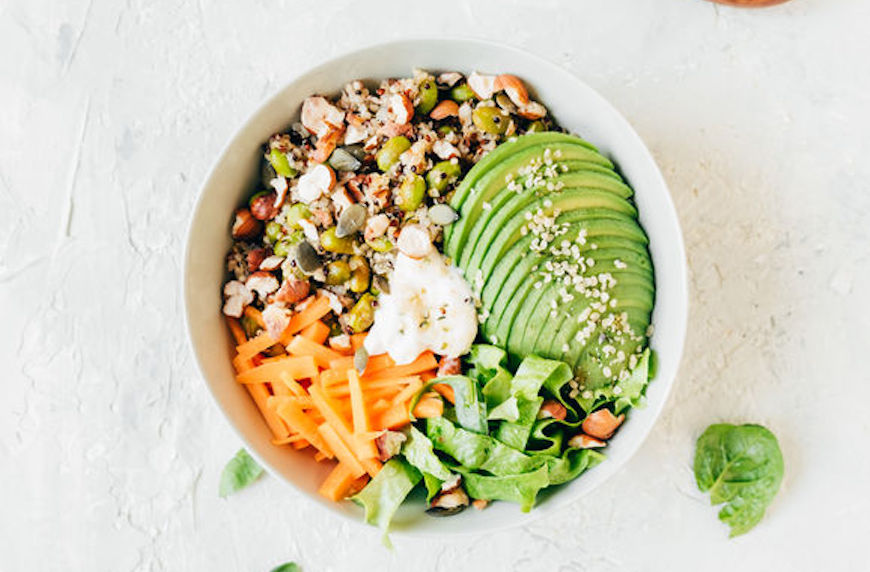
Want to try keto but don’t eat meat? Try Plant Based Keto.
When someone says the words “ketogenic diet,” the first things that come to mind are probably butter, bacon, and avocados. That’s because the trendy diet has a rep for being heavy on the animal-based fats. (Just look up “ketogenic recipes” and you’ll see what I mean.) Here is some insight on a Plant based Keto diet for those of you interested.
This makes the eating plan appealing to carnivores…but what about those of us who might want to reap some of those much-touted keto benefits (less brain fog, balanced hormones, healthy weight management, etc etc) without loading up on meat?
Enter the “Ketotarian” diet, outlined by Will Cole, D.C., functional medicine practitioner in his book Ketotarian: The (Mostly) Plant-Based Plan to Burn Fat, Boost Your Energy, Crush Your Cravings, and Calm Inflammation. He essentially argues that it is possible to do plant based keto diet. Color me intrigued! Here’s what you need to know:
What is the Ketotarian diet?
Ketotarian takes the traditional ketogenic diet and adds a plant-based twist. “It allows those who prefer to be more plant-based or have sensitivities to these foods to still take advantage of the benefits of ketosis,” says Cole.
A high-fat, moderate protein and very low-carb eating plan, the Ketotarian diet eliminates meat and dairy and focuses on plant-centric sources of fats. It also allows some animal sources of protein and fats, including eggs, ghee, and fish—although those foods aren’t required. If you’re vegan, you don’t eat them on this plan; if you’re a vegetarian, you can if you’d like.
The foods you can eat as a Ketotarian look like this
- Non-starchy vegetables (like artichokes, asparagus, and salad greens)
- Low-fructose fruits (Cole says that include berries, lemons, and limes)
- Plant-based fats (such as nuts, seeds, coconuts, olives, vegetable oils, and avocados)
Off the menu, however:
- Meat
- Dairy
- Starchy vegetables (like potatoes, corn, and peas)
- Grains
- High-fructose fruits (like mangoes, apples, and watermelon)
- Legumes like lentils, beans, and peanuts.
How is plant based keto different from the traditional keto diet?
Both the ketogenic and Ketotarian diets are high-fat and very low-carb. Their goal is to reach ketosis—where you’re burning fat for energy because you’re eating minimal carbs and have used up all of your body’s glycogen stores (i.e., glucose mostly housed in your liver and muscles).
While people on the OG ketogenic diet may heavily rely on meat and some types of dairy for fat and protein, the Ketotarian diet focuses on fish and plant-based sources. Nutritionist Kristen Mancinelli, R.D., however, says that a meat-heavy diet is a misconception of keto. “Most people go at the keto diet thinking it’s steak and hamburgers without the bun, but that’s not really what you’re supposed to be eating,” she says. She counsels her clients who are on the keto diet to rely on fish and eggs as much as possible, with smaller amounts of meat and cheese.
“Most people go at the keto diet thinking it’s steak and hamburgers without the bun, but that’s not really what you’re supposed to be eating.”
—Kristen Mancinelli, R.D.
One big difference: You can have more carbs on the Ketotarian plan. It allows for up to 15 percent of your calories to come from carbs, as long as they come from vegetables; on traditional keto it’s as few as 5 percent, according to Mancinelli. The Ketotarian macros generally look like this: 60 to 75 percent of calories from fat, 15 to 30 percent of calories from protein, and up to 15 percent of calories from carbs.
There are also a few foods that are generally keto no-nos that are perfectly fine on the Ketotarian plan, including tempeh and natto (both made from fermented soybeans) and low-fructose fruits. “Tempeh and natto have to low negligible net carbs because of the fiber. They are allowed since they are fermented, which makes them easier on your digestion,” says Cole. He adds that low-fructose fruits have less of an impact on your blood sugar levels and pushing you out of ketosis.
“I haven’t seen research to suggest that low-fructose fruits are compatible with a ketogenic diet. My perspective is to generally avoid fruit, and if you want a fruit treat sometimes then a serving of berries can usually work.”
—Kristen Mancinelli, R.D.
Can you get enough plant-based protein and still restrict carbs?
The biggest challenge on a fully vegan keto diet is getting enough protein, says Mancinelli, since many plant-based sources of protein (like beans and quinoa) are off the table because of their carb count. The average person needs to eat 0.8 to 1 grams of protein per kilogram of body weight per day, says Mancinelli; if you’re 140 pounds (about 65 kilos), that works out to 50 to 65 grams per day.
However, it still is possible if you rely strategically on the right sources. Cole says a number of protein sources on the Ketotarian diet are vegan and low-carb, including:
- Hempeh (tempeh made from hemp seeds): 22 grams protein per 4 ounces
- Natto (organic, non-GMO): 31 grams protein per 1 cup
- Tempeh (organic, non-GMO): 31 grams protein per 1 cup
- Hemp protein powder: 12 grams protein per 4 tablespoons powder
- Hemp hearts/seeds: 40 grams protein per 1 cup
- Nutritional yeast: 5 grams protein per 1 tablespoon
- Sacha inchi seed protein powder: 24 grams protein per 4 tablespoons powder
- Spirulina: 4 grams protein per 1 tablespoon
Is going Ketotarian better for the environment?
In general, any eating plan that involves fewer animal products can benefit the environment, because produce generally takes fewer resources to grow (and have a smaller carbon footprint) than meat. “The industrial food system is horribly damaging to the environment,” says Mancinelli. Meat and dairy are two of the biggest causes of greenhouse gas emissions, and require large amounts of water and land use—while studies show plant-based diets can cut a person’s carbon footprint by half.
Are there any potential risks or downsides?
Mancinelli cautions that women who are pregnant or breastfeeding, children, the elderly, those with chronic health conditions, and anyone with a history of an eating disorder should only try restricted diets—including keto-based diets—if they’re under a health-care provider’s supervision.
But Cole says that the Ketotarian diet can work for anyone. “Ketotarian is a nutrient-dense diet of primarily whole, real foods, with lots of healthy plant and omega fats, clean protein, lots of non-starchy vegetables and low fructose fruits,” he says. “This is not radical or dangerous…Of course, anyone who is pregnant should talk with their doctor about the whole healthy foods they are eating.”
How long does a Ketotarian diet last?
When a person first starts on a ketogenic or Ketotarian diet, both Mancinelli and Cole suggest aiming for 20 to 30 grams net carbs (that’s total carbs minus total fiber per serving) per day to kickstart ketosis. Cole says, however, that some people can aim for to 50. “Since every person is different, your individual macronutrient ratios will vary depending on your weight, height, age, sex, and activity level,” says Cole.
Cole suggests that first-timers go fully Ketotarian for their first eight weeks. He then advocates for what he calls a cyclical Ketotarian approach, where four to five days per week a person eats a ketogenic, mostly plant-based diet, and the other two to three days they incorporate some carbs in the form of fruits and starches like sweet potatoes and rice. (This is essentially carb cycling.) “Most people don’t have to be in ketosis long-term but [one] should create metabolic flexibility to get the benefits,” he says. Of course, eating carbs will bump you out of ketosis, but Mancinelli says you’ll be back on it within six to 12 hours of resuming your diet.
The Ketotarian plan might be a bit more restrictive compared to its mainstream keto counterpart. But ask pretty much any nutritionist, ketogenic fan or not, and they’ll likely say that eating a plant-based diet is better for your health than a diet that’s high in animal proteins and fats. And it might be a bit better for the planet too.
For more trendy diet 101, here’s why the Mediterranean diet exploded back onto the scene this year. And if you care about the environment, you should probably know about the planetary health diet.
Click here to view original web page at Want to try keto but don’t eat meat? Introducing the Ketotarian diet
Also, check out Plant-Based Diets Good for the Planet, and for You

